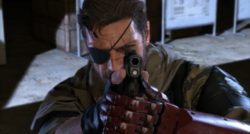Metal Gear Solid V: A Retrospective Review
Alone and afraid, one last solider radios HQ to relay the strange noises he’s been hearing. They tell him to stop messing them around, and so he nervously carries on his patrol route. Something is obviously up – his entire unit, along with two enormous tanks, seem to have disappeared – but it sounded like HQ wasn’t kidding, so best just to get on with it.
A noise behind the soldier causes him to turn around, whereupon he is confronted with an intruder. Suddenly, a seemingly identical copy also looms out of the darkness to his right. Within moments, the soldier is surrounded by 9 copies of his enemy. To his credit, it doesn’t take him long to find the real culprit, but nor does it take me long to dispatch him with my customised assault rifle. The tank unit is destroyed, and my mission is complete.
The Phantom Pain excels at letting you choose the way you want to combat a problem.
I knew as soon as I saw my target for this mission that I wasn’t going to be able to take the unit on all guns blazing, but that doesn’t mean my approach – sticking to the shadows, luring enemies away from the group, before putting them to sleep and kidnapping them – was the only one available to me. I could have called in an air strike and blown the whole unit up in one huge explosion; I could have found a vantage point and picked off the terrified soldiers one by one with my silenced sniper rifle; I could even have radioed base to bring me my own tank and gone in, er, all guns blazing.
Metal Gear Solid V: The Phantom Pain excels at letting you choose the way you want to combat a problem. Sure, you could kidnap that enemy commander and interrogate him, but equally, you could kill him from 200 yards away and be gone before anyone knew you were there. This freedom wouldn’t be so effective if The Phantom Pain wasn’t so much fun to use; going on a rampage with an assault rifle is just as satisfying as laying traps for an unwitting patrol or convoy, or sneaking through an entire prison unseen to conduct a rescue mission.
While the game’s breadth of content is impressive, its environmental depth is the perfect accompaniment. While the open worlds of the game’s primary locations – Soviet-controlled Afghanistan and the Angola-Zaire border – are a little sparse, the mission environments themselves are wonderfully well designed, combining narrow passages that promote the game’s focus on stealth with wide open spaces in which it’s significantly more difficult to stay out of the enemy’s site. Something I also particularly enjoyed was the game’s weather effects, all of which have an impact on the rest of the game; sandstorms reduce visibility, making it easier for you to get the drop on an enemy, but also easier for you to stumble into them by accident; rain provides plenty of background noise to help you sneak past guards unheard; clouds provide little impact during the day, but if the sky clears during the night, the light provided by a full moon will make you much easier to spot.
While mechanically, The Phantom Pain is nearly flawless (given the quality of the rest of the game, I felt the AI were occasionally a bit lacking), the story doesn’t quite match up. For a series as old as Metal Gear Solid, there was obviously a lot of fan service needing to be paid, but even from the perspective of someone largely unaware of the story behind the rest of the franchise, a lot of it seems to have been done just for the sake of mentioning old characters who otherwise could have been left out. Different story threads also don’t quite seem to ever knit together – missions about rescuing child soldiers have little bearing on a killer parasite epidemic, and I was lead to wonder why both of these stories were being told at the same time.
The Phantom Pain is one of the best stealth games of the decade
While Act One is, for the most part, well-paced, with a finale that I would have been happy ending the game at, Act Two is much shorter, incorporating almost no ‘actual’ missions, and in fact is largely made up of ‘challenge’ versions of previous missions. While I don’t know enough about the in-fighting at Konami to really comment on its impact on the finished game, it’s a real shame that the project couldn’t have come to a more definitive ending, one actually in keeping with the game as a whole.
Despite the slightly disappointing second act, Metal Gear Solid V: The Phantom Pain is one of the best stealth games of the decade, largely due to its desire to not select a definitive way to play, offering you countless ways to succeed, and never feeling like it’s punishing you for your choice. There’s well over 40 hours of content in the main story alone, and with more than 6 weeks left before term starts, it’s well worth checking out.


Comments